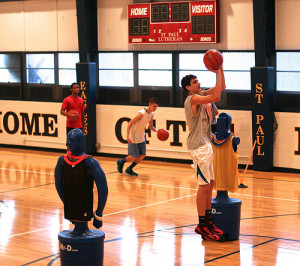Eight Tips to Change-up your Drills
There are a number of reasons why as a coach should look to Change-up your Drills. Many coaches over the course of several years will develop a Drill Bank, into which they add drills they have used and found to be beneficial. These drills while often providing a number of benefits for your team can become rather stale for the players and staff if utilised too heavily.

There is also the danger of the well-rehearsed drill becoming its own self-fulfilling reason for continuing to utilise that specific exercise. This means if a drill is focused on too much it can lose its benefit of acting as a tool to isolate certain tactics of the game of basketball. At the core of all drills should be a goal of leading to a more efficient game performance. Not just being able to perform a drill well.
Coaches should also be aware that when you change-up your drills you bring a breath of fresh air for your team and staff. Not to mention you can create a new and sharpened focus for your team. Depending on what you change and emphasise.
The first thing you can do as a change-up for your drills is to alter the focus from offense to defence or vice versa. Most drills are often explained and written focusing on one specific phase of play (offense or defence). But every drill does not have to be exclusively this way; many can just as easily be changed to focus on the other phase of play.
A second option you can use to change-up your drills is to time each drill to maximise repetitions. Most drills once you become familiar with the pattern can be sped up or slowed down to achieve certain goals. A way of bringing a different intensity to the execution of the drill is to ask for more repetitions then usually performed. This is a great technique for instilling urgency into your players and creating artificial pressure when performing activities.
Many drills focus on achieving a certain score or reaching a target first that is related to points. To change-up your drills why not focus on a defensive target. You might state the winning team is the first to make three stops in a row. Alternatively, the winning team might be the first group to get a defensive rebound, steal and take a charge.
Wan to challenge your offensive players more as you change-up your drills? Limit the amount of dribbles an offensive player can use once they have the ball. A very simple strategy, but very effective in making your offensive players become efficient in using their dribbles. This is great for junior and senior teams alike. One dribble is all that is needed for senior players at the three-point line to attack the basket. Anymore creates bad habits like wasting time with the ball or over dribbling.
A good way to challenge your offensive players further when you change-up your drills is to create rules within drills for help defence to engage as a an additional defender. This is good for creating game like situations for your offensive players to play against. By adding a help defender you can also emphasis rules under which your defenders should engage an offensive player and when they should not. When first starting out with this technique, be sure to create help rules for your defenders which limit their movement otherwise the offense will become overwhelmed and this can be more damaging and helpful. As the offense becomes more and more effective you can vary your help defence rules to allow for greater pressure on the offensive player.
Always a good strategy to help with the change-up of your drills is to restrict the space your offensive players can utilise within the drill. Limiting the areas the offense can utilise is a good way to mimic game like scenarios where help defenders would normally engage. Another benefit of this strategy is will help your offensive players become comfortable in playing in tight and crowded spaces with defensive players. This is a great strategy for many options out of the two player game where space is always at a premium.
Another option to change-up your drills is to make every exercise a competitive situation. This is a fantastic technique for adding extra intensity and making each drill a challenge for your players. It also represents a shift in your focus from running drills for drills sake, to preparing for game situations every moment of every training session. An example of this point in action, is during a shooting drill have the rebounder pass to the next shooter and then close-out to the ball. In this scenario you can play until the shot, or even extend the play to include boxing-out and rebounding of the shot.
Finally, consider adding multiple possessions to change-up your drill repetitions. This works best if you are able to create a situation where the players can play continuously. You do not have to play in the full court; this can be achieved in the half court just as well. By adding this change-up to your drill you will find it exposes a whole range of different areas to work on with your players.
As a coach you should be looking to create a comprehensive drill bank to draw from that allows you not to over use your drills in training. However, ever coach has their favourite activities they will like to run during their training sessions. But using the change-ups listed above should help keep your drills fresh and stimulating for your players.








Leave a Reply